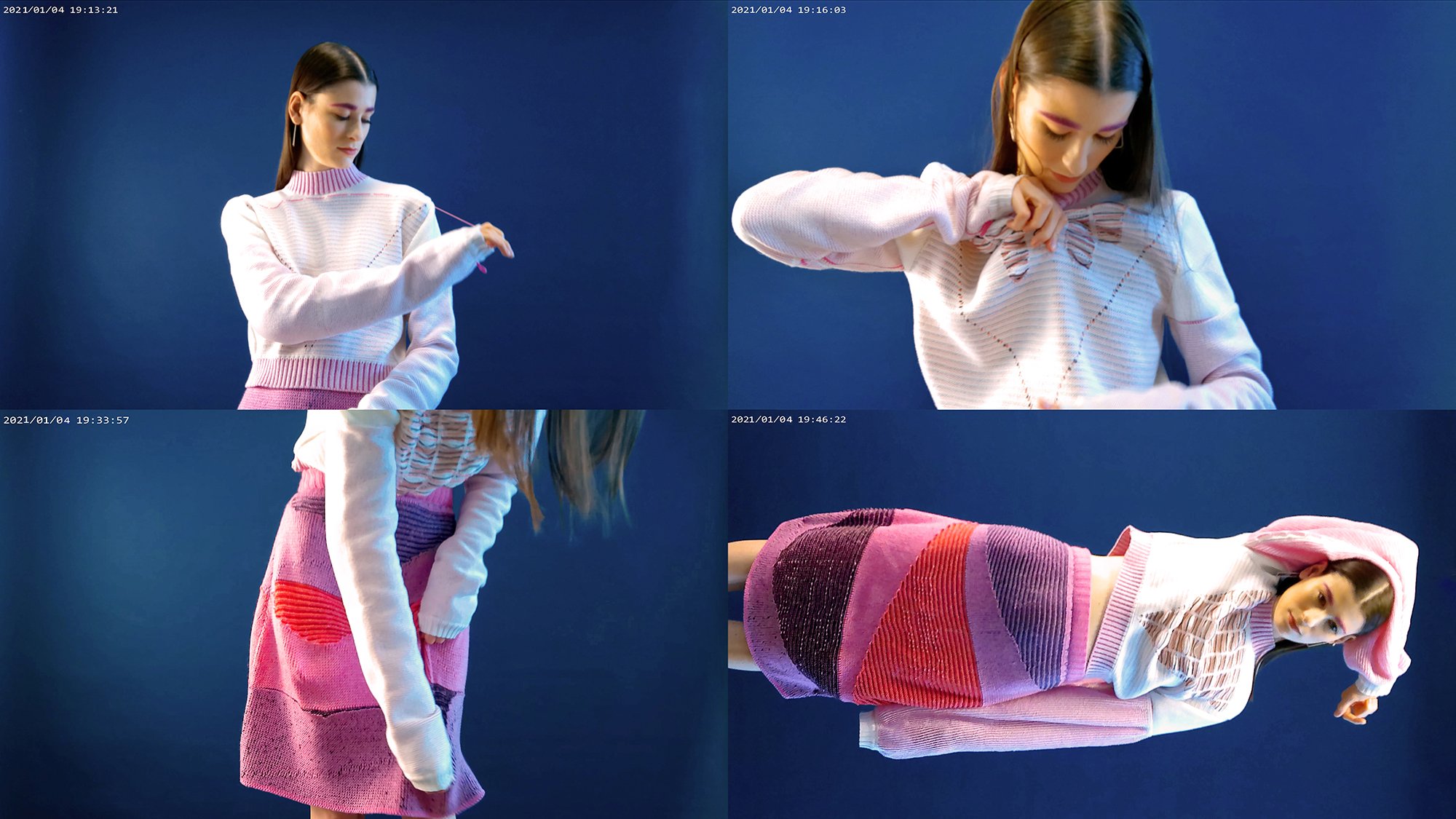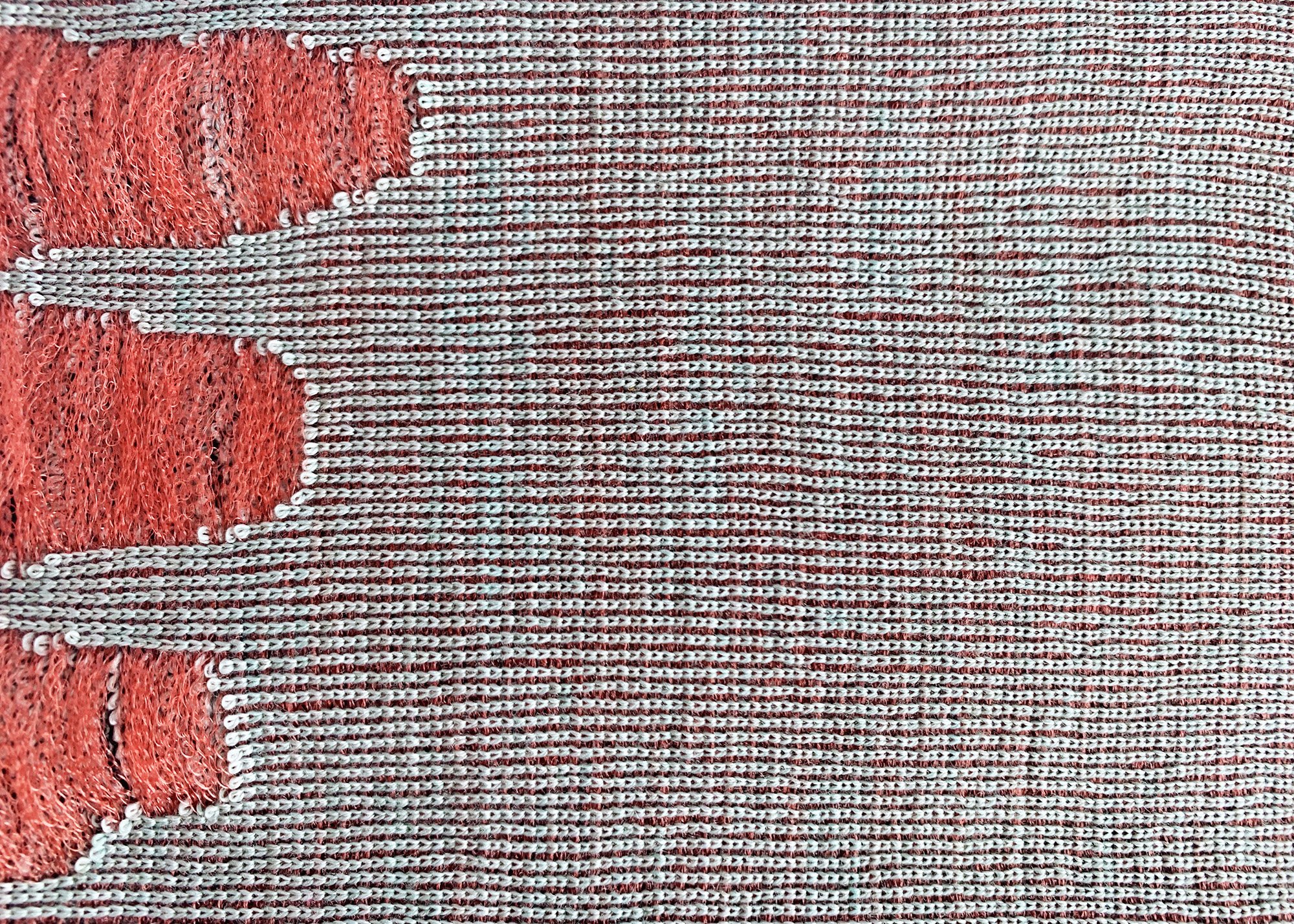
Key details
Date
- 18 April 2023
Read time
- 5 minutes
Rosalba Fucci (MA Textiles, 2021) works for Alexander McQueen as an assistant designer in knitwear. Discover how her time at the RCA shaped her approach to fashion and knitwear.
Key details
Date
- 18 April 2023
Read time
- 5 minutes
Having studied fashion design in Italy, Rosalba came to the RCA to expand her creativity on the MA Textiles programme. While at the RCA she won the Worshipful Company of Framework Knitters Award 2020 and the Shima Seiki Student Competition 2021.
Motivated by a body positive approach, Rosalba’s work at the RCA redefined the relationship between garment and wearer through a machine knit technique that creates fabric that transforms through interactions with the wearer.
“I wanted to develop my individuality and creative identity, and the RCA was the right place for it.”
MA Textiles alumna

Before coming to the RCA you were working in the Italian fashion industry. What motivated you to return to studying, and why did you choose MA Textiles at the RCA?
While the industry-focused education I received in Milan gave me an amazing design foundation, I was missing the eclectic and out-of-the-box way of teaching fashion that I knew was a reality in London. I wanted to develop my individuality and creative identity, and the RCA was the right place for it. I also hoped that studying at the RCA would open more doors for me, especially in terms of contacts in the fashion industry.

For your graduate work you made a collection of garments that can be permanently transformed by the wearer. How did this concept come about?
Initially, I experimented with different techniques that could distort shape within the knitted fabric, and I analysed how these techniques behaved in relation to the body. I became obsessed with a particular knitted structure, because I noticed the fabric needed to be manually pulled to make the stitches “open” in previously determined areas, changing the fabric and creating interesting visual effects.
This inspired me to take advantage of this manual interaction, re-interpreting what is traditionally a decorative effect in a functional way. I realised that applied to garments this structure could not only inform their construction and silhouette, but could also be interactive, becoming the tool I was looking for to recreate a connection between the garment and the body.

Why did you choose to explore the relationship between the body and the garment?
During my fashion studies, the more I looked at how tailored garments are conceived, the more I realised that they are often purposely built to shape the body and hide its imperfections in order to achieve the “perfect silhouette” considered essential for true elegance and beauty.
These concepts are neither modern nor positive, because they imply that the body is wrong and that clothes need to correct it. Too often the clothes we wear seem to be created not for the body but rather against it, not only ignoring its natural shapes and changing them forcefully but also neglecting its need for movement, freedom and comfort. This is what creates a disconnection between clothes and the wearers’ bodies.
I strongly believe in “knit’s power of making things better”. Knitted fabric really understands and respects the body, enables movement, provides comfort and warmth. I wanted to use knit to achieve a new way of designing and experiencing garments, in an attempt to rebuild a lost connection between clothes and the wearers’ bodies. I wanted to subvert existing power relations, bringing the body and the wearer back to a leading position.

“I had amazing support from my tutors [...] They challenged me with the right questions and pushed me past what I thought were my limits.”
MA Textiles alumna
How did the Textiles programme help you to develop this idea, both conceptually and through the technical support offered?
I had amazing support from my tutors (Amanda Griffiths, Freddie Robins, Vicki Fong and many others) who assisted and encouraged me throughout the whole journey. They challenged me with the right questions and pushed me past what I thought were my limits.
What I liked about the College (but also what scared me the most) was the complete freedom of expression I was given and the fact that no one ever asked me to fit in any box or to adhere to any pre-existing structure.
I also received technical assistance from the university, in terms of manual and digital knitting machines, technician consultations, and the possibility to explore all the machinery available in other departments (3D scanning, screen printing, dyeing etc...) looking for the best tools to make my ideas become more tangible.

After graduating you took part in the Burberry graduate program as a knitwear design assistant. Do you feel like studying at the RCA helped you to gain this position?
A Burberry recruiter contacted me after she saw my work on the RCA2021 digital platform. That specific opportunity did not end up being suitable for me, but after a few months a spot in the graduate program opened up.
This one-year adventure has been life-changing for me in terms of understanding how such a big luxury company works, gaining precious design experience, being backstage at a runway show for the first time, and making lots of contacts in the industry.
On the other hand, it also opened my eyes to many controversial aspects of working in this sector of the industry. This made me start questioning what kind of future I want for my career. My goal is to gain as much work experience in the knitwear industry, come across as many realities as possible, and eventually find my niche.

“There are many skills from my time at the College that I draw on daily.”
MA Textiles alumna
Now you work for Alexander McQueen as a Trainee in Knitwear Design. Are there things from your time at the College that you use in your work now?
There are many skills from my time at the College that I draw on daily, like the use of programs like Illustrator, Photoshop and InDesign, my extensive technical knowledge in knitwear construction, knitted textiles and yarns properties, and my ability to always problem-solve and push boundaries in a creative way.
I encourage everyone to use their Master's degree to really develop the skills that they think will be important for their future career, especially if they want to work across different fields, taking advantage of the cross-programme opportunities and the high quality of teaching and peer review available.

What most inspires you about knit design?
Over the course of time, knitwear has been left un-investigated and under-appreciated, despite its incredibly unique characteristics. Now it is finally gaining the spotlight.
I love its ability to create something extremely crafty, handmade, and soft as well as something extremely technological, machine-made, sharp and cutting-edge.
I love having to consider the material from the very beginning of the design process, starting from a cone of yarn and directly ending up with textured surfaces and tridimensional shapes, without any in-between stage. This requires the knitwear designer to constantly blend technical and creative knowledge at every step of the process.

Where do you see the future of knit design?
I honestly feel like the future of knit design is very bright, and not just because the leisurewear and loungewear markets are growing. We are starting to recognise that knitwear does not only mean ivory-cable-knit-jumpers, but anything from socks to dresses to jackets to shoes to furniture covers can be knitted, even if they don’t look like it.
Digital knitting machines are able to produce textiles that appear and behave just like woven fabrics (denim, just to name a very popular one), but that are made using an alternative additive process that minimises production waste compared to traditional cut-and-sew methods.
With new avant-garde technologies, it is also possible to program a tridimensional garment in its integrity and let the machine knit it in a very short amount of time, without the need for any additional process from cast on to cast off.
Maybe I’m exaggerating, but I see a future where most of our fabric-made products will be knitted.
